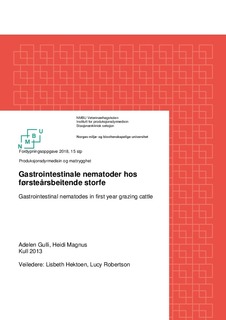| dc.contributor.advisor | Hektoen, Lisbeth | |
| dc.contributor.advisor | Robertson, Lucy | |
| dc.contributor.author | Gulli, Adelen | |
| dc.contributor.author | Magnus, Heidi | |
| dc.date.accessioned | 2019-06-20T07:49:24Z | |
| dc.date.available | 2019-06-20T07:49:24Z | |
| dc.date.issued | 2019 | |
| dc.identifier.uri | http://hdl.handle.net/11250/2601473 | |
| dc.description.abstract | I denne studien har det blitt analysert 64 avføringsprøver av storfe fra åtte ulike melkebesetninger fra Oslo og Buskerud. Prøvene ble undersøkt for gastrointestinale nematoder. Målet for oppgaven har vært å undersøke forekomsten av gastrointestinale nematoder hos storfe på sommerbeite. Avføringsprøvene ble tatt fra førsteårsbeitende ungdyr. Prøvene ble tatt ved innsett høsten 2018, som varierte fra oktober til desember hos besetningene vi har undersøkt. Avføringsprøvene har blitt analysert for parasittegg med kvantitative og kvalitative metoder. Informasjon om beitetype og parasittbehandling hos de ulike besetningene ble også registrert. Tre av besetningene hadde blitt behandlet med parasittmiddel våren i forkant av undersøkelsen. Parasittene som ble påvist i studien er Strongylida, Moniezia, Dicrocoelium dendriticum, og Eimeria spp. Spesielt for 2018 var en sommer preget av tørke. Det har mest sannsynlig påvirket parasittenes overlevelsesevne i beitegresset og medvirket til generelt lave nivåer av parasitter hos alle de undersøkte besetningene. Ingen av besetningene fikk påvist betydelige nivåer av gastrointestinale nematoder. | nb_NO |
| dc.description.abstract | In this study, 64 fecal samples from 8 dairy herds around Oslo and Buskerud county was analyzed for gastrointestinal nematodes. The main purpose was to investigate the occurrence of gastrointestinal nematodes in cattle on pasture. The fecal samples were collected from young stock after their first grazing season. Collection of the samples was completed in the autumn of 2018 after the animals had been collected from the pasture. The time of collection ranged from October to December. The fecal samples were analyzed with both quantitative and qualitative methods. Information about what kind of pasture utilized and any parasite treatment was registered as well. Three of the herds treated their animals with anthelmintics during spring. The parasites detected in this case study was Strongyles, Moneizia, Dicroceilum dendriticum, and Eimeria. The summer of 2018 was characterized by drought. This has most likely had an impact on the parasites ability to survive and reproduce and therefore caused low levels of parasites in the examined herds. None of the herds had a significant level of gastrointestinal nematodes. | nb_NO |
| dc.language.iso | nob | nb_NO |
| dc.publisher | Norwegian University of Life sciences, Ås | nb_NO |
| dc.rights | Attribution-NonCommercial-NoDerivatives 4.0 Internasjonal | * |
| dc.rights.uri | http://creativecommons.org/licenses/by-nc-nd/4.0/deed.no | * |
| dc.title | Gastrointestinale nematoder hos førsteårsbeitende storfe | nb_NO |
| dc.title.alternative | Gastrointestinal nematodes in first year grazing cattle | nb_NO |
| dc.type | Student paper, others | nb_NO |
| dc.source.pagenumber | 42 | nb_NO |
| dc.description.localcode | VET | nb_NO |

